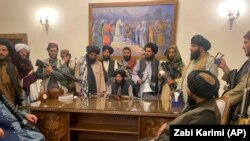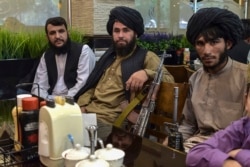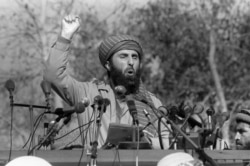Since the Taliban seized the Presidential Palace in Kabul on August 15, the world has been warily monitoring the situation in Afghanistan.
As one senior Taliban member told VOA on August 24, the group is seeking international recognition. But to date, no state recognizes them as the “legitimate representative government of the people of Afghanistan.”
Many countries remain skeptical about the Taliban’s pledges to respect women, grant amnesty to those who fought them and deny safe haven for terrorist groups.
China, whose foreign minister just hosted a Taliban delegation in July, was quick to make overtures to the organization.
That despite Beijing’s own concerns about the fundamentalist Islamic group seizing control in a country it shares a short border with.
A day after the Taliban came to power, Chinese Foreign Ministry Spokesperson Hua Chunying implied that the “major changes” in Afghanistan reflected “the will and choice of the Afghan people.”
On the same day, People’s Daily, the official newspaper of the Chinese Communist Party (CCP), posted on Weibo, a Chinese social media platform where it has 139 million followers, a paragraph titled “What Kind of Organization is the Taliban?”
It briefly described the origins and development of the group, noting that “Taliban means students in Persian,” and that the group was formed by “students from refugee camps” during the civil war that followed the Soviet withdrawal.
Explaining the rapid growth of the group in the 1990s, the post continued: “Thanks to receiving the support of the poor in Afghanistan, the strength of the Taliban grew dramatically.”
That is highly misleading.
For sure, the Taliban were initially greeted as a stabilizing force in the war-torn country. But the People’s Daily post made no mention of the Taliban’s violent past, which quickly drew a storm of criticism from Weibo users, who accused it of “whitewashing” an “anti-human regime.”
The post also omits the indispensable support received from foreign actors, mainly Pakistan and Saudi Arabia, which gave the group the necessary military prowess to defeat opposing domestic forces and declare an Islamic Emirate in 1996.
The Taliban, which does mean “students” in Pashto, emerged from fighting the war against Soviet occupation of Afghanistan between 1979-89. Students from religious schools (madrasas) in Afghanistan and northern Pakistan were recruited as mujahideen, groups of Islamic guerrilla fighters who received extensive support from the Inter-Services Intelligence (ISI), Pakistan’s military intelligence agency.
Mullah Omar, founder of the Taliban, was among the mujahideen trained by the ISI during that period. According to an article by Bruce Riedel, director of The Intelligence Project at Brookings Institute, a Pakistani hospital also provided Omar with medical treatment for war injuries.
Seeing an opportunity to wage a proxy war against the Soviet Union, the United States and Saudi Arabia channeled much of their support for the mujahideen resistance through the ISI. According to Human Rights Watch (HRW), an international human rights watchdog group, the United States funneled $2 billion to $3 billion worth of covert assistance to the mujahideen through the ISI, training more than 80,000 of those guerrilla fighters to fight the Soviets.
After Moscow left Afghanistan in 1989, various mujahideen factions vied for control. Afghanistan quickly descended into a brutal civil war. Omar rallied a group of other mujahideen trained and supported by the ISI in the fight against Soviet forces, creating the Taliban in 1994.
War-weary Afghans were eager to end the infighting and return to some degree of normalcy. The Taliban did win some popular support in its early stage due to its vows to restore stability and its purported support of Islamic values, and its success in battling corruption, installing law and order, and providing safety for trade activities in the Taliban-controlled regions.
The newly formed Taliban continued to receive critical support from Pakistani military and the ISI, and later joined by Saudi Arabia. “Pakistan provided experts and advisers for the Taliban military, oil for its economy and was their supply route to the outside world,” wrote Riedel.
The Taliban eventually captured Kabul and established the Islamic Emirate of Afghanistan (IEA) in 1996. Pakistan was first to recognize Taliban governance in 1997, followed by Saudi Arabia and United Arab Emirates (UAE). Only those three offered official recognition of the Taliban.
Though Islamabad routinely denied its role in providing any military or financial support to the Taliban, a report titled "Crisis of Impunity: The Role of Pakistan, Russia, and Iran in Fueling the Civil War in Afghanistan" issued in July 2001 by HRW detailed how Pakistan, mainly the ISI, contributed “to making the Taliban a highly effective military force.”
“Of all the foreign powers involved in efforts to sustain and manipulate the ongoing fighting, Pakistan is distinguished both by the sweep of its objectives and the scale of its efforts, which include soliciting funding for the Taliban, bankrolling Taliban operations, providing diplomatic support as the Taliban's virtual emissaries abroad, arranging training for Taliban fighters, recruiting skilled and unskilled manpower to serve in Taliban armies, planning and directing offensives, providing and facilitating shipments of ammunition and fuel, and on several occasions apparently directly providing combat support,” HRW wrote in the report.
In a pivotal battle to obtain control of Herat in April 1995, the Taliban initially suffered a grim defeat against government troops due to insufficient ammunition and logistical support. But the Taliban quickly launched a successful counterattack against government forces, utilizing 4x4 pickup trucks in August 1995.
The HRW report noted that the pickup trucks were delivered to the Taliban with help from Pakistan, and “introduced a kind of mobile warfare that had not been seen in the fighting before.” A similar combat tactic was used in the Taliban’s fight to take control of Jalalabad and Sarobi in 1996.
On its road to seizing Kabul in 1996, “the Taliban forces … used mobility and maneuvers that were more characteristic of a professional army-specifically, of professional officers and noncommissioned officers trained in the practice of mobile warfare-than of Afghan mujahideen,” the report said.
HRW also confirmed and detailed Pakistan’s role in recruiting and training volunteer fighters for the Taliban. Sources included a retired senior Pakistani military officer, an official from the "United National Islamic Front for the Salvation of Afghanistan" (United Front), the opposing force against the Taliban in the civil war, and several captured Pakistani volunteer fighters.
HRW said that “up to 30 percent of Taliban fighting strength is made up of Pakistanis serving in units organized by [Pakistani] political parties” and “another 8-15,000 troops, according to another source, are foreigners, principally Arabs from Gulf states and North Africa.”
HRW also said that the Taliban volunteer fighters they interviewed “described their Pakistani trainers as being … military in appearance and speech …” The report went on to say that “one ex-Taliban fighter described meeting a former Pakistani artillery colonel who claimed to have volunteered to work with the Taliban artillery forces” to make them better.
HRW also described how private traders in Pakistan helped the Taliban financially. The report said “duties imposed on trucks transiting Afghanistan from Pakistan became the Taliban's most important official source of income.” The Taliban pulled in some $75 million in 1997 from “taxing the Afghanistan-Pakistan smuggling trade,” according to a World Bank estimate.
As Pakistan decided to back the Taliban in the group’s infancy, Saudi Arabia provided financial support and more. “Western journalists saw white-painted C-130 Hercules transport aircraft, which they identified as Saudi Arabian, at Qandahar (Kandahar) airport in 1996 delivering artillery and small-arms ammunition to Taliban soldiers,” the report said.
Pakistani support for the Taliban attracted widespread international criticism.
Kofi Annan, then U.N. secretary-general, said in December 2000 that it was “deeply distressing that a significant number of non-Afghan personnel, largely from Pakistani madrassahs, are … taking active part in the fighting, most, if not all, on the side of the Taliban.”


